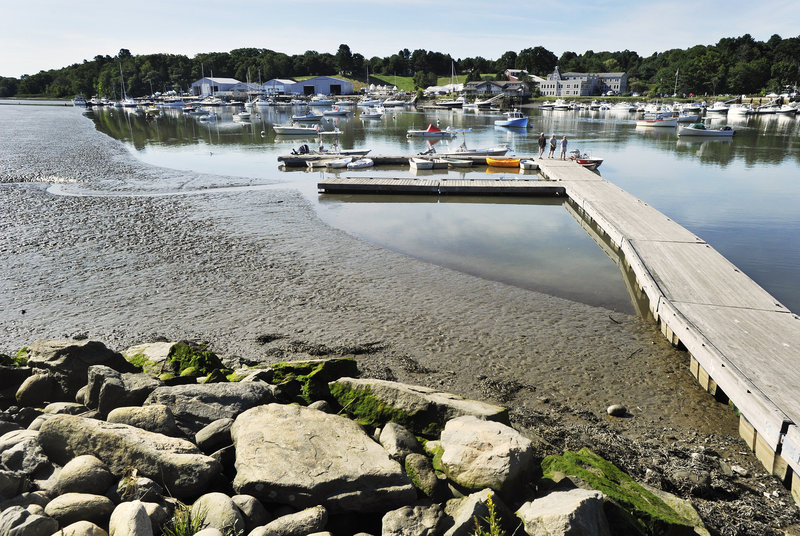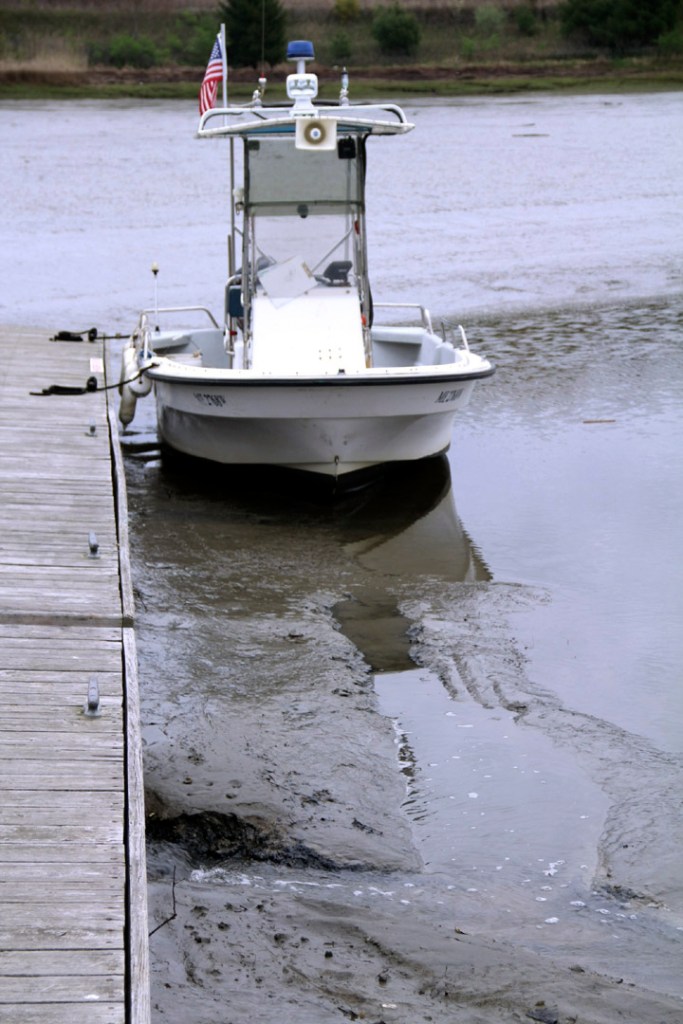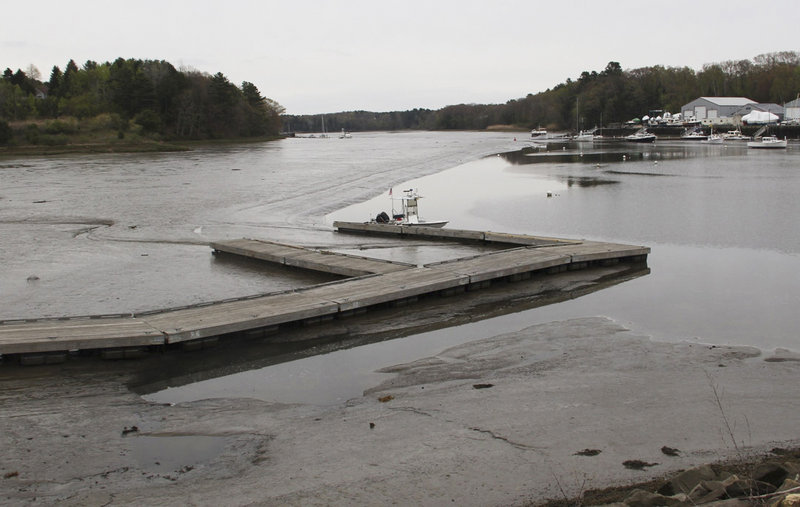YARMOUTH – Every couple of weeks, the tide in Yarmouth Harbor drops so low, the widening mouth of the Royal River becomes a muddy basin divided by a meandering, shallow channel that stretches all the way to Browns Point.
Locals call the events “super drainers,” but even when the tidal drop is less drastic, lobster boats and other watercraft can wind up stuck in the mud. Most of the town’s 16 lobstermen keep their boats outside the harbor to avoid the hassle.
“About half the time, most of our moorings have less than 2 feet of water at low tide, and you need at least 3 feet for a lobster boat,” said Harbor Master Richard Imbeault.
The grounding problem grows worse each year that the federal government fails to dredge the harbor. It’s a U.S. Army Corps of Engineers maintenance project that’s about seven years overdue because of budget cuts and the Royal River’s status as a comparatively low-use, shallow-draft, recreational harbor.
Yarmouth’s six-acre mooring field, which holds 51 boats, is supposed to be at least 6 feet deep at low tide, according to federal navigation standards set in the 1860s. The navigational channel, which is supposed to be at least 8 feet deep at low tide, measures 4 feet in most places.
Now, town officials are trying to link the $3 million dredging project to their ongoing effort to remove two dams upriver. They hope to win support from federal agencies that are promoting fisheries- and river-restoration efforts.
Town Manager Nat Tupper has appealed to the Environmental Protection Agency, trying to leverage concern about sediment that might be released if the town removes old dams at Bridge Street and East Elm Street.
While initial testing indicates there’s no problem with sediment contamination at either dam, some residents fear that dam removal may compound the need to dredge the harbor, which should be done every 10 years, Tupper said.
The Royal River was last dredged in 1995, he said, when Yarmouth’s cleaner sediment was used to cap contaminated sediment from Portland Harbor that was dumped at sea.
In September, the Town Council is expected to consider spending $10,000 on a broader study to determine whether science supports dam removal and how it might affect the harbor.
“Dam removal and dredging are already linked in the minds of many townspeople,” Tupper said.
Some say linking dam removal and dredging is a long shot. They note that the Army Corps’ strict funding priorities favor big, busy, commercial harbors, largely because the agency’s $1.5 billion annual budget for navigational projects is down 50 percent from six years ago.
The New England District of the Army Corps has a $400 million backlog of smaller coastal dredging projects, including York, Wells, Kennebunk, Biddeford Pool, Saco, Scarborough and Yarmouth.
At the same time, Portland Harbor, last dredged in 1999, is on track to get $13 million for dredging in the coming year.
“Unfortunately, our budget’s being cut like every other federal agency, and the Royal River doesn’t rise to the top,” said Ed O’Donnell, regional chief of the Army Corps’ navigation section.
O’Donnell offered little encouragement that Yarmouth’s attempt to link dredging with dam removal might build enough political support to move it up the Army Corps’ priority list.
“It might help influence things,” he said, “but as the (funding) process is now, probably not.”
Still, town officials are hopeful, since the June election stacked the Town Council with a majority of members who support both dam removal and dredging as critical to the future of Yarmouth and other communities in the Royal River’s 141-square-mile watershed.
“For Yarmouth, dredging isn’t an option, it’s an imperative,” said Steve Woods, the council’s chairman and an independent U.S. Senate candidate. “An undredged harbor is a threat to a big part of Yarmouth’s economy, to tourism, to the boating industry and to Yarmouth’s identity.”
Yarmouth Harbor generates $25.3 million a year in commercial revenue and 343 jobs in the recreation, tourism, fishing, boatbuilding and transportation industries, according to the Greater Portland Council of Governments.
One of those money-and-job generators is Yankee Marina and Boatyard, a 47-year-old family enterprise that’s being affected by the undredged harbor.
Yankee Marina must dredge its waterfront annually to maintain access to 100 slips, said Deborah Delp, company president. She says the marina is losing potential customers because some people are concerned about running aground.
“They call us and say, ‘We’re afraid of the river. We’re not coming,’ ” Delp said. “We have to dredge our personal space a lot more because it just fills in. We pulled out 2,200 cubic yards of mud last fall, but nothing seems to matter to the Army Corps. It’s very frustrating.”
Staff Writer Kelley Bouchard can be contacted at 791-6328 or at:
kbouchard@pressherald.com
Send questions/comments to the editors.





Success. Please wait for the page to reload. If the page does not reload within 5 seconds, please refresh the page.
Enter your email and password to access comments.
Hi, to comment on stories you must . This profile is in addition to your subscription and website login.
Already have a commenting profile? .
Invalid username/password.
Please check your email to confirm and complete your registration.
Only subscribers are eligible to post comments. Please subscribe or login first for digital access. Here’s why.
Use the form below to reset your password. When you've submitted your account email, we will send an email with a reset code.